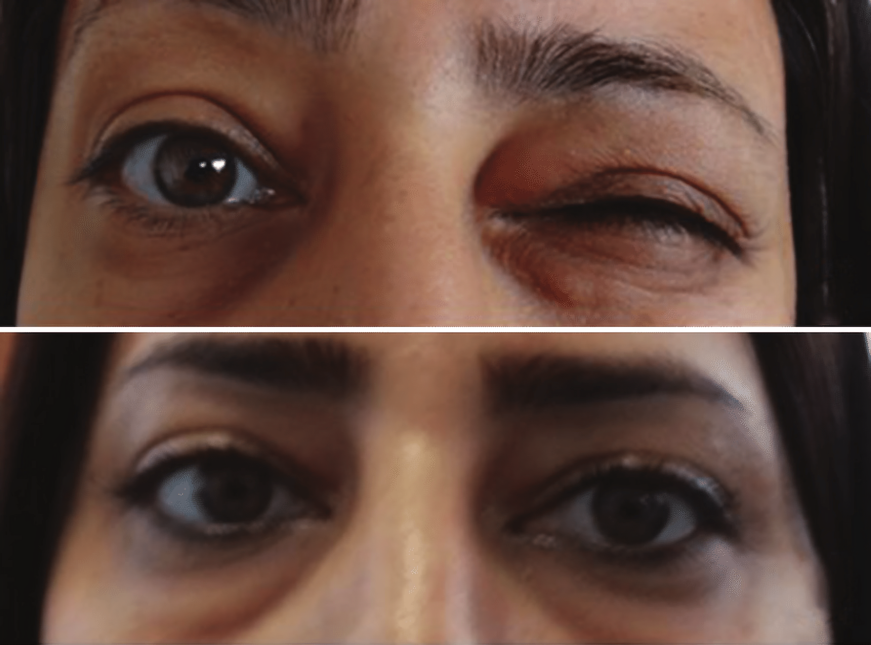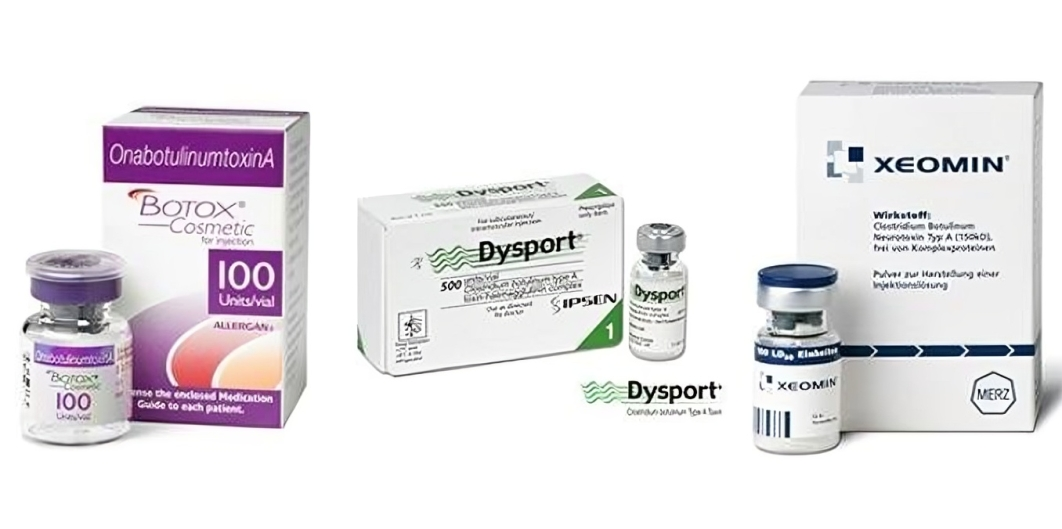Dysport is a type of injection commonly used for cosmetic purposes and to treat various muscular disorders. Like Botox, it is a botulinum toxin, but they have different characteristics and uses.
What is Dysport?
Dysport is an injectable medication. It is the brand name of abobotulinumtoxin A, a botulinum toxin. Botulinum toxins are neurotoxins derived from Clostridium botulinum bacteria. As neurotoxins, they act on the synapses and neuromuscular junctions in your body, which are the connecting clefts between different neurons and muscles, respectively. They do so by releasing different neurochemicals and causing your muscles to relax. This way, they help healthcare professionals achieve many desirable aesthetic, neurological, and physical medical results.1Field, M., Splevins, A., Philippe Picaut, Marcel, Langenberg, J., Daan Noort, & Foster, K. (2018). AbobotulinumtoxinA (Dysport®), OnabotulinumtoxinA (Botox®), and IncobotulinumtoxinA (Xeomin®) Neurotoxin Content and Potential Implications for Duration of Response in Patients. Toxins, 10(12), 535–535. https://doi.org/10.3390/toxins10120535
How does Dysport work?
Dysport is administered in the form of an injection into different target muscles, depending on the patient’s complaint. It resolves various health conditions by temporarily relaxing the muscles that it has been injected into.
Once inside the muscle, it disrupts the synapse between that muscle and its nerve supply. It inhibits the release of acetylcholine, the neurotransmitter that controls muscle contractions. Without acetylcholine, muscles cannot contract. They stay stuck in a relaxed state until the effects of Dysport wear off.2Simpson, D. M., Hallett, M., Ashman, E. J., Comella, C. L., Green, M. W., Gronseth, G. S., Armstrong, M. J., Gloss, D., Potrebic, S., Jankovic, J., Karp, B. P., Naumann, M., So, Y. T., & Yablon, S. A. (2016). Practice guideline update summary: Botulinum neurotoxin for the treatment of blepharospasm, cervical dystonia, adult spasticity, and headache. Neurology, 86(19), 1818–1826. https://doi.org/10.1212/wnl.0000000000002560
FDA-Approved Indications of Dysport
Even though Dysport is a relatively novel treatment, the FDA has approved it for several medical conditions.3U.S. Food and Drug Administration. (2016). Dysport (abobotulinumtoxinA) label. https://www.accessdata.fda.gov/drugsatfda_docs/label/2016/125274s107lbl.pdf
Adult Cervical Dystonia
Cervical disorder is a common movement disorder. It causes abnormal neck posture, pain, and tremors. Multiple studies have shown that Dysport is a safe and effective first-line treatment for treating cervical dystonia. Dysport’s therapeutic effects for cervical dystonia usually last 8 to 12 weeks.4Spiegel, L. L., Ostrem, J. L., & Bledsoe, I. O. (2020). FDA Approvals and Consensus Guidelines for Botulinum Toxins in the Treatment of Dystonia. Toxins, 12(5), 332–332. https://doi.org/10.3390/toxins12050332
Glabellar Lines
Glabella is the area between your eyebrows. It is especially prone to signs of aging. Wrinkles or “glabellar lines” on this part of your face give a false angry or sad appearance. Dysport injections can smoothen them out for up to five months.5Joely Kaufman-Janette, Sue Ellen Cox, Dayan, S., & Joseph, J. (2021). Botulinum Toxin Type A for Glabellar Frown Lines: What Impact of Higher Doses on Outcomes? Toxins, 13(7), 494–494. https://doi.org/10.3390/toxins13070494
Limb Spasticity
Limb spasticity is a chronic neuromuscular condition in which muscles contract, stiffen, and tighten for long periods. You also lose voluntary control of them. Dysport relaxes them for 12 to 16 weeks upon administration.6Schnitzler, A., Clément Dince, Freitag, A., Iheanacho, I., Fahrbach, K., Lavoie, L., Loze, J.-Y., Forestier, A., & Gasq, D. (2022). AbobotulinumtoxinA Doses in Upper and Lower Limb Spasticity: A Systematic Literature Review. Toxins, 14(11), 734–734. https://doi.org/10.3390/toxins14110734
Non-FDA Approved Indications of Dysport
This injection is used off-label for a variety of conditions. Even though it currently does not have FDA approval for its treatment, it has shown significant consequences:
- Cosmetic anti-ageing procedures
- Blepharospasm
- Hemifacial spasm
- Spasmodic dysphonia
- Retracted eyelids
- Cerebral palsy
- Stroke
- Multiple sclerosis
- Spinal cord injury
- Chronic migraines
- Anal fissures
- Excessive Sweating

What are the Contraindications of Dysport?
The treatments are avoided in certain conditions:
- Interchangeable use with other Botulinum toxins
- Known allergy to Dysport
- Known allergy to cow’s milk, as cow protein is a component of Dysport injection
- Pregnancy
- Breastfeeding
- Neuromuscular disorders such as
o Myasthenia gravis
o Eaton-Lambert syndrome
o Amyotrophic lateral sclerosis - Infection at the injection site
- Children under two and a half years of age
How to Prepare for Dysport Treatment?
The treatment is usually performed at the medical office, clinic, or hospital where a healthcare provider with expertise in aesthetic medicine is based. Before that, your doctor will have an appointment to discuss the procedure with you and your desired outcomes. If you’re getting Dysport for glabellar lines, they might get some photographs for a before-and-after comparison.

History & Physical Exam
It is necessary to get a detailed patient history before administering Dysport injections because of its contraindications, side effects, and drug interactions. Your doctor will ask you about:
- Medication use
- History of neuromuscular disorders
- Allergies, especially to bovine milk protein
- Past or ongoing treatments with other botulinum toxins like Botox
Depending on the indication you’re getting Dysport, your doctor will thoroughly examine you to determine if you’re the right candidate for this procedure. If you’re getting it for signs of aging, they will assess your skin and facial structure. Similarly, they will complete a neurological exam if you get Dysport for any form of spasticity.
Informed Consent
Although this is a minimally invasive procedure, it still has a number of potential side effects because it’s derived from a dangerous neurotoxin. For this reason, doctors will fully inform you about the procedure, give you educational materials about it, and ask you to sign a consent form before it is performed.
Anesthesia for Dysport
In the case of glabellar lines, a highly skilled cosmetic physician uses an incredibly fine needle to insert Dysport into your muscles. Because of this, Dysport treatments don’t usually require anesthesia. However, doctors often numb your skin with local anesthetic topically to foolproof your pain-free experience.
Sometimes, Dysport is used for more uncomfortable procedures like the examination and treatment of anal fissures. In these cases, a small amount of general anesthesia is employed briefly.
Do’s & Don’ts Before Dysport Treatment
Your doctor will encourage you to take up a few healthy practices before you get your treatment:
- Go to a qualified doctor with experience in your particular kind of Dysport treatment.
- Tell your doctor about the goals you want to achieve with this procedure.
- Stop consuming alcohol at least three days before your treatment.
- Avoid taking blood thinners, NSAIDs, and supplements at least three days prior to your appointment.
The Procedure of Dysport Treatment for Cervical Dystonia
Dysport procedures are slightly different depending on the body tissues, but the major steps remain the same:
- Your doctor will clean the injection site to avoid infections.
- They will mark the areas the exact area where they will inject you.
- Next, they will get the appropriate solution and inject Dysport into your muscles with a fine needle. Other than a slight sting, you won’t feel any discomfort or pain.
- Once all the solution has entered your tissues, they will remove the needle.
- They will apply a cold compress to the site to reduce swelling and bruising.
Dysport is a first-line treatment of cervical dystonia. A patient Around 500-1000 units are administered to the selected neck muscles during an appointment:
- 50 to 250 units for semispinalis capitis
- 50 to 350 units for sternocleidomastoid
- 75 to 450 units for splenius capitis
- 50 to 300 units for trapezius
- 50 to 300 muscles for the scalenus medium and scalenus medius
- 50 to 200 units for levator scapulae
Doctors use aseptic measures and sterile syringes to inject your muscles with different units of Dysport. They often use an ultrasound or electromyography to guide the procedure. They may also limit the dose to lower the chances of side effects, such as dysphonia.
Side Effects of Dysport Treatment for Cervical Dystonia
Because the neck is a sensitive body part with many significant structures, there are a few side effects of Dysport treatment for cervical dystonia:
- Dysphagia
- Injection site pain
- Muscle weakness
- Fatigue
- Dysphonia7Fasano, A., Vijayashankar Paramanandam, & Jog, M. (2020). Use of AbobotulinumtoxinA in Adults with Cervical Dystonia: A Systematic Literature Review. Toxins, 12(8), 470–470. https://doi.org/10.3390/toxins12080470
Process of Dysport Treatment for Glabellar Lines
Dysport for glabellar lines is a 15-20 minute outpatient procedure. It targets two muscles: the corrugator and procerus muscles. The corrugator muscles are located above the eyebrow and form vertical lines. The procerus is situated in the middle of the forehead, on top of the nose. It causes horizontal lines on the nose and in between your eyebrows.
At first, the injection site is appropriately cleaned and prepared for Dsyport. Usually, 50 units of Dysport are administered for glabellar lines at an angle lateral to the skin. They are divided into five different areas, each receiving 10 units of Dysport:
- Two 10-unit injections for the right corrugator muscle
- Two 10-unit injections for the left corrugator muscle
- One 10-unit injection for the procerus muscle
Side Effects of Dysport Treatment for Glabellar Lines
There are several side effects for facial lines, such as:
- Headache
- Drooping eyelid
- Stuffy, runny nose
- Sore throat
- Sinusitis
What Happens During Dysport Treatment for Limb Spasticity?
This injection improves the symptoms of upper and lower limb spasticity in both pediatric and general populations. Most patients require retreatments at 12 to 16 weeks, but there should be a gap of at least 12 weeks between treatments. The maximum dose that can be given at a time is 1500 units.
| Dysport Units for Upper Limb Spasticity | Dysport Units for Lower Limb Spasticity |
| Total: 500 to 1000 units in different sites | Total: 1000 to 1500 units in different sites |
| One or two injections of 100-200 units in flexor carpi radialis | Two injections in the gastrocnemius muscle
100-150 units in the medial head 100-150 units in the lateral head |
| One or two injections of 100-200 units in flexor carpi ulnaris | Three injections of 330 to 500 units each in soleus |
| One or two injections of 100-200 units in flexor digitorum profundus | Two injections of 200-300 units each in tibialis posterior |
| One or two injections of 100-200 units in flexor digitorum sublimis | One to two injections of 130-200 units each in flexor digitorum longus |
| One or two injections of 200-400 units in brachialis | One injection of 70-200 units in flexor hallucis longus |
| One or two injections of 100-200 units in brachialis | |
| One or two injections of 200-400 units in biceps brachii | |
| One injection of 100-200 units in pronator teres |
Side Effects of Dysport for Limb Spasticity
A variety of side effects have been reported by patients after treatment for limb spasticity:
- Weakness in the limb
- Injection site reactions
o Pain
o Bruising
o Hemorrhage
In addition to adverse effects localized to the area being treated, sometimes, the whole body gets affected by the distant effects of Dysport. They are similar to symptoms caused by botulism:
- Generalized muscle weakness
- Severe fatigue and tiredness
- Double vision
- Blurred vision
- Trouble swallowing
- Trouble speaking
- Urinary incontinence
Dysport After Care: What are the Do’s and Don’ts
This is an outpatient procedure that lasts under half an hour. You’ll soon be discharged with a list of instructions for aftercare:
- Avoid strenuous activities for a few hours afterward.
- Avoid massaging, rubbing, or even touching the injection site immediately after Dysport.
- If you were sitting when your injection was administered, sit upright for 4-6 hours so that the medication remains in place in your muscles.
- Apply an ice pack in the first 24 hours to prevent bruising

Signs of Allergic Reactions to Dysport
Like other medications, Dysport has a chance of triggering an allergic reaction in your body. Sometimes, this allergic reaction can morph into anaphylactic shock and become life-threatening. So, it’s essential to identify the signs of allergic reactions to Dysport, which include:
- Difficulty breathing
- Shortness of breath
- Swelling of your throat, lips, or tongue
- Weak pulse
- Rash
- Itching
- Redness
- Hives
- Loss of consciousness
Taking Other Medicines With Dysport Treatment
These injections can interact with many other medicines and supplements. Therefore, you are advised to avoid certain drugs before and after your appointment day:
- Aspirin
- Anticoagulants like warfarin
- Aminoglycoside antibiotics
o Gentamycin
o Polymyxin - Drugs for Alzheimer’s disease
o Galantamine
o Rivastigmine
o Tacrine - Drugs for myasthenia gravis
o Ambenonium
o Pyridostigmine - NSAIDs like ibuprofen
- Quinidine
- Energy drinks
- Supplements and herbs
o Vitamin E
o St. Johns Wart
o Diet pills
o Herbal teas
o Bilberry
o Cayenne pepper
o Dong Quai
o Ginseng
o Cayenne
o Echinacea
o Licorice Root
o Melatonin 8(2024, June 5). Medscape.com. https://reference.medscape.com/drug/dysport-abobotulinumtoxina-999220
Pros & Cons of Dysport Vs. Botox
Dysport and Botox are both neurotoxins derived from the botulinum toxin, so they have many shared characteristics and are often used for the same indications. They differ slightly in chemistry and their dosage:
- Dysport acts faster than Botox by showing results seven days earlier.
- Dysport consists of small molecules that the skin can absorb better.
- Many patients report a softer and more natural-looking appearance than Botox.
- The per-unit cost of Dysport is lower than that of Botox.
- Dysport is more challenging to find because it’s used less frequently than Botox.
- More Dysport units are required in each session.
Conclusion
Dysport is a medical treatment used for cosmetic purposes and to treat neuromuscular disorders. It is used in the form of an injection. It is similar to Botox. Even though the procedure of Dysport administration is safe, it has several side effects that need to be taken into account. It shows great results and is quickly becoming popular among patients for treating various medical conditions.
Refrences
- 1Field, M., Splevins, A., Philippe Picaut, Marcel, Langenberg, J., Daan Noort, & Foster, K. (2018). AbobotulinumtoxinA (Dysport®), OnabotulinumtoxinA (Botox®), and IncobotulinumtoxinA (Xeomin®) Neurotoxin Content and Potential Implications for Duration of Response in Patients. Toxins, 10(12), 535–535. https://doi.org/10.3390/toxins10120535
- 2Simpson, D. M., Hallett, M., Ashman, E. J., Comella, C. L., Green, M. W., Gronseth, G. S., Armstrong, M. J., Gloss, D., Potrebic, S., Jankovic, J., Karp, B. P., Naumann, M., So, Y. T., & Yablon, S. A. (2016). Practice guideline update summary: Botulinum neurotoxin for the treatment of blepharospasm, cervical dystonia, adult spasticity, and headache. Neurology, 86(19), 1818–1826. https://doi.org/10.1212/wnl.0000000000002560
- 3U.S. Food and Drug Administration. (2016). Dysport (abobotulinumtoxinA) label. https://www.accessdata.fda.gov/drugsatfda_docs/label/2016/125274s107lbl.pdf
- 4Spiegel, L. L., Ostrem, J. L., & Bledsoe, I. O. (2020). FDA Approvals and Consensus Guidelines for Botulinum Toxins in the Treatment of Dystonia. Toxins, 12(5), 332–332. https://doi.org/10.3390/toxins12050332
- 5Joely Kaufman-Janette, Sue Ellen Cox, Dayan, S., & Joseph, J. (2021). Botulinum Toxin Type A for Glabellar Frown Lines: What Impact of Higher Doses on Outcomes? Toxins, 13(7), 494–494. https://doi.org/10.3390/toxins13070494
- 6Schnitzler, A., Clément Dince, Freitag, A., Iheanacho, I., Fahrbach, K., Lavoie, L., Loze, J.-Y., Forestier, A., & Gasq, D. (2022). AbobotulinumtoxinA Doses in Upper and Lower Limb Spasticity: A Systematic Literature Review. Toxins, 14(11), 734–734. https://doi.org/10.3390/toxins14110734
- 7Fasano, A., Vijayashankar Paramanandam, & Jog, M. (2020). Use of AbobotulinumtoxinA in Adults with Cervical Dystonia: A Systematic Literature Review. Toxins, 12(8), 470–470. https://doi.org/10.3390/toxins12080470
- 8(2024, June 5). Medscape.com. https://reference.medscape.com/drug/dysport-abobotulinumtoxina-999220

